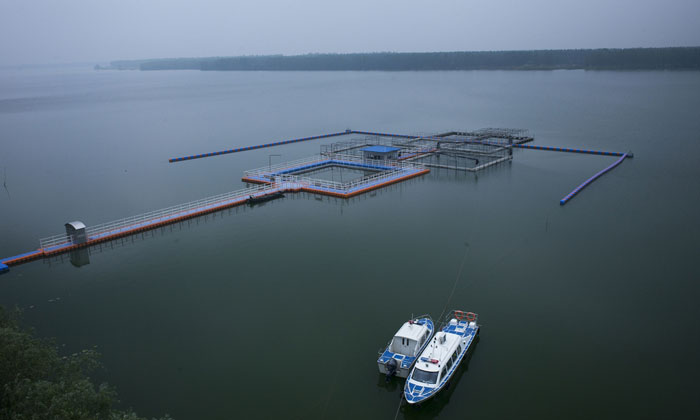

A picture of China's "smiling angel," the Yangtze finless porpoise Photo: IC

One of the ex-situ conservation zones in Shishou, Central China's Hubei Province Photo: IC
The Yangtze finless porpoise is often called the "giant panda of the water" due to its rarity. The only freshwater subspecies of the finless porpoise in the world, this endangered species can only be found in China's Yangtze River. Due to its low population, it has been ranked as a first-class national protected animal in China, putting it on par with the giant panda.
Edge of extinction
The Yangtze finless porpoise is a cetacean mammal living in the middle and lower reaches of the Yangtze River, including Poyang Lake in East China's Jiangxi Province and Dongting Lake in Central China's Hunan Province.
Light blue-gray or gray-white in color and with a lifespan of around 20 years, the Yangtze finless porpoise is much loved in China because of its adorable smiley face and lively temperament.
The International Union for Conservation of Nature designated the finless porpoise as an endangered species back in 1996 due to its low number and the condition of its habitat. Since 1993, the population of Yangtze finless porpoises has dropped from 2,700 to a bit more than 1,000 today.
"There were three large-scale research surveys carried out in 2006, 2012 and 2017. [According to these surveys] we can see the decline in porpoise number was very obvious from 2006 to 2010, while conditions improved from 2012 to 2017 since we were very alarmed by the endangered situation of the finless porpoise," Wang Kexiong, a leading researcher at the Institute of Hydrobiology, Chinese Academy of Sciences, told the Global Times on Tuesday.
According to a report from WWF China, the Yangtze finless porpoise may disappear from the Earth within 15 years if effective conservation measures are not implemented.
Comprehensive measures
During the 13th Five-Year Plan (2016-20), China introduced comprehensive measures to save the Yangtze finless porpoise.
In response to research challenges encountered in the field, the establishment of an artificial breeding and research center was one of the measures for saving the marine mammal.
"There is a bioacoustics and behavior laboratory that focuses on studies such as the finless porpoises' underwater vocalizations, its hearing and the impact of underwater noise on them," Wang explained.
In addition to establishing eight natural reservations to protect the Yangtze finless porpoise, three ex-situ conservation zones were established in cities such as Shishou in Central China's Hubei Province and Anqing, East China's Anhui Province. Newly designed facilities and equipment, such as nets and net cages, were introduced to these reservations to better improve the porpoises' habitat for breeding.
The Action Plan to Save the Yangtze Finless Porpoise (2016-25) published by China's Ministry of Agriculture and Rural Affairs in 2016 contained major guidance for conservation efforts. It set seven objectives, such as the development of artificial breeding technology, improvement of reservations and increase in promotional efforts to encourage the public and all sectors of society to participate in protection efforts.
"It is not enough to have only the government and research institutions participate in efforts to save the porpoises," said Wang.
Founded in 2017 in Wuhan, the Saving Yangtze Finless Porpoise Alliance is an association of 60 members that include conservation authorities, research institutes and social organizations.
"The direction of our work is social publicity - advocating and popularizing understanding of the finless porpoise among the public and delivering the concept of conservation to them," Wang Shicheng, a staff member at the Nanjing Yangtze Finless Porpoise Conservation Association in Nanjing, East China's Jiangsu Province, told the Global Times on Tuesday. The association is one of the important members of the alliance dedicated to saving the Yangtze finless porpoise.
Similar associations have taken root in other cities such as Yueyang, Central China's Hunan Province.
As Wang noted, "we, as a social organization, act like a bridge to link research institutions, the local government, educational institutions and the general public to save the porpoises." These groups have made social contributions to save the species by launching public educational courses and activities to raise people's awareness about conservation efforts.
"We are thinking about designing and installing underwater equipment under bridges in Wuhan. When the animal shows up, the sound will send an alarm to a phone app. Then citizens can install the app to know where the Yangtze finless porpoise is," Wang said.
In addition to upcoming plans such as reintroducing adult Yangtze finless porpoises from ex-situ conservation zones to the wild and sharing China's advanced experience with ex-situ conservation to the world, Wang recommends focusing more on using innovative technological measures in the digital age to protect the endangered species, as well as working on restoring the relationship between people and the Yangtze finless porpoise as they both need the Yangtze River to survive. (Global Times)

86-10-68597521 (day)
86-10-68597289 (night)

52 Sanlihe Rd., Xicheng District,
Beijing, China (100864)

